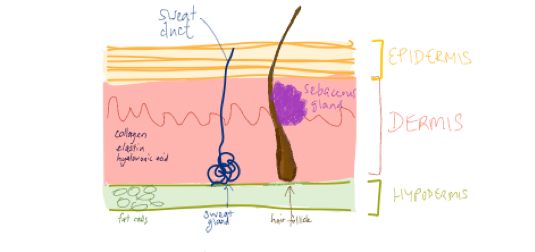Your Skin Layers & About pH
Your skin has a thin, protective layer on its surface called the acid mantle. This acid mantle should be slightly acidic – at about a pH of 4.5-5.75.
It is made up of sebum (free fatty acids) excreted from the skin’s sebaceous glands, which mixes with lactic and amino acids from sweat to create your skin’s pH.
As you age your skin pH increases, becoming more alkaline. As pH increases and your skin becomes more alkaline, it also gets dry and sensitive and is unable to fight a destructive enzyme that destroys collagen. This causes wrinkles and skin sagging.
Your skin has 3 main layers and they all have very important functions.

- Epidermis
- Dermis
- Hypodermis
The epidermis has five layers. It is a waterproof barrier that protects the body against UV radiation, bacteria, viruses, fungi, heat and water loss. It makes skin cells and gives skin its colour. In the lower layers of the epidermis new skin cells (keratinocytes) are made. Over about four weeks they travel to the top, harden, die and are called corneocytes. They are usually shed but can accumulate.
The dermis has two layers. It contains blood vessels and connective tissue which gives the skin its strength and elasticity. It also makes sweat and oil, provides skin sensation and blood to the skin, grows hair, and has heat receptors as it contains sweat glands and lymphatic vessels.
The hypodermis/subcutaneous tissue attaches the dermis to the body. It stores fat for insulation protection and provides padding, controls body temperature and gives your skin its blood and nerve supply. The fat cells make vitamin D.

